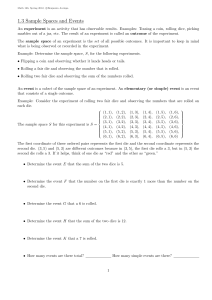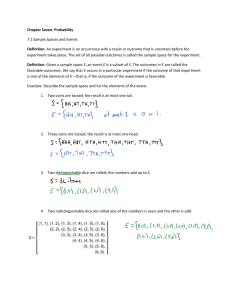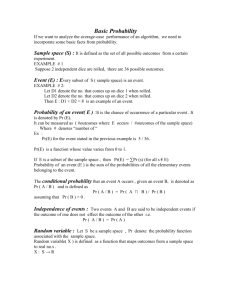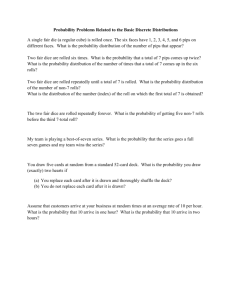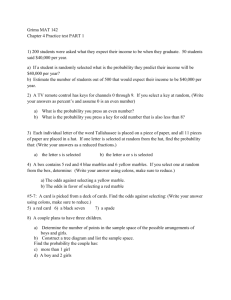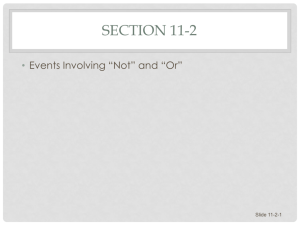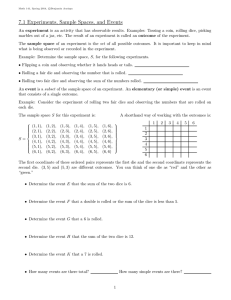Document 10504235
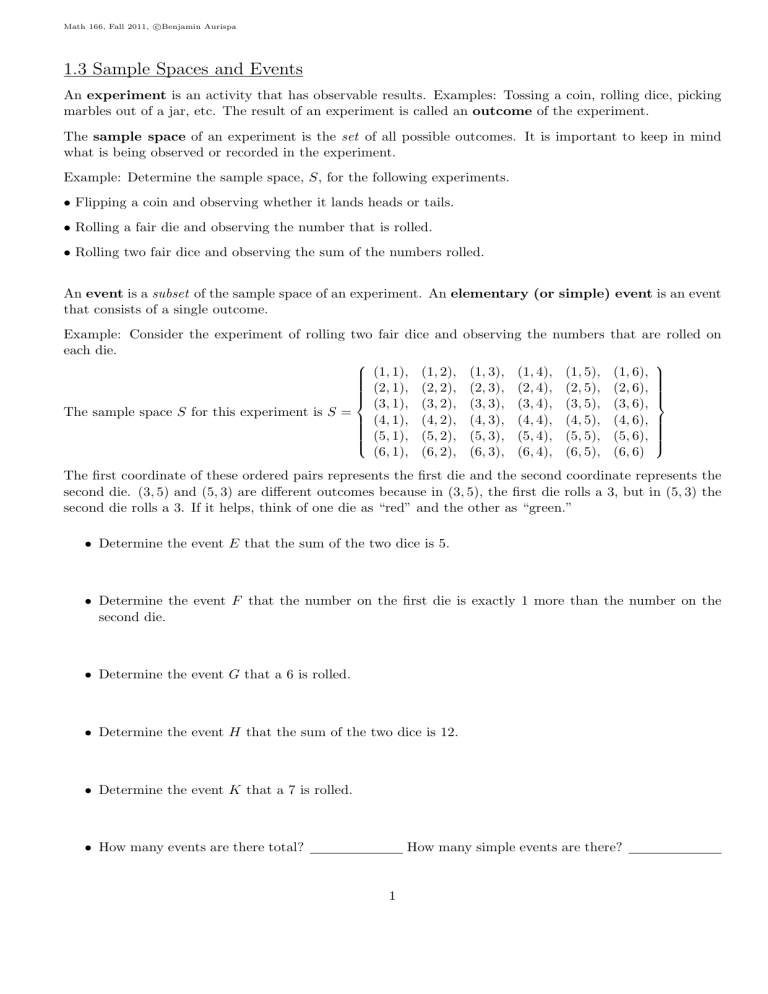
Math 166, Fall 2011, c Benjamin Aurispa
1.3 Sample Spaces and Events
An experiment is an activity that has observable results. Examples: Tossing a coin, rolling dice, picking marbles out of a jar, etc. The result of an experiment is called an outcome of the experiment.
The sample space of an experiment is the set of all possible outcomes. It is important to keep in mind what is being observed or recorded in the experiment.
Example: Determine the sample space, S , for the following experiments.
• Flipping a coin and observing whether it lands heads or tails.
• Rolling a fair die and observing the number that is rolled.
• Rolling two fair dice and observing the sum of the numbers rolled.
An event is a subset of the sample space of an experiment. An elementary (or simple) event is an event that consists of a single outcome.
Example: Consider the experiment of rolling two fair dice and observing the numbers that are rolled on each die.
The sample space S for this experiment is S =
(1 , 1) , (1 , 2) , (1 , 3) , (1 , 4) , (1 , 5) , (1 , 6) ,
(2 , 1) , (2 , 2) , (2 , 3) , (2 , 4) , (2 , 5) , (2 , 6) ,
(3 , 1) , (3 , 2) , (3 , 3) , (3 , 4) , (3 , 5) , (3 , 6) ,
(4 , 1) , (4 , 2) , (4 , 3) , (4 , 4) , (4 , 5) , (4 , 6) ,
(5 , 1) , (5 , 2) , (5 , 3) , (5 , 4) , (5 , 5) , (5 , 6) ,
(6 , 1) , (6 , 2) , (6 , 3) , (6 , 4) , (6 , 5) , (6 , 6)
The first coordinate of these ordered pairs represents the first die and the second coordinate represents the second die. (3 , 5) and (5 , 3) are different outcomes because in (3 , 5), the first die rolls a 3, but in (5 , 3) the second die rolls a 3. If it helps, think of one die as “red” and the other as “green.”
• Determine the event E that the sum of the two dice is 5.
• Determine the event F that the number on the first die is exactly 1 more than the number on the second die.
• Determine the event G that a 6 is rolled.
• Determine the event H that the sum of the two dice is 12.
• Determine the event K that a 7 is rolled.
• How many events are there total?
How many simple events are there?
1
Math 166, Fall 2011, c Benjamin Aurispa
The empty set ∅ is called the impossible event .
The sample space S is called the certain event , since whatever outcome occurs is guaranteed to be in S .
We can have unions, intersections, and complements of events just as before. If E and F are two events of an experiment, then:
• E ∪ F is the set of outcomes that are in E or F , i.e.
E ∪ F is the event that E OR F (or both) occurs.
• E c is the set of outcomes that are not in E , i.e.
E c is the event that E does NOT occur.
• E ∩ F is the set of outcomes that are in both E and F , i.e.
E ∩ F is the even that both E AND F occur.
If two events CANNOT happen at the same time, then E ∩ F = ∅ , and these events are said to be mutually exclusive . (The sets E and F are disjoint .)
From the dice example above we saw that E = { (4 , 1) , (3 , 2) , (2 , 3) , (1 , 4) } , F = { (2 , 1) , (3 , 2) , (4 , 3) , (5 , 4) , (6 , 5) } , and G = { (1 , 6) , (2 , 6) , (3 , 6) , (4 , 6) , (5 , 6) , (6 , 6) , (6 , 1) , (6 , 2) , (6 , 3) , (6 , 4) , (6 , 5) } .
Are E and F mutually exclusive?
Are E and G mutually exclusive?
Often, tree diagrams can be used to help find the sample space.
Example: Suppose I flip a coin twice and record whether the coin lands heads or tails on each toss.
• Determine the sample space for this experiment.
• Determine the event E that at least 1 tail is tossed.
• Determine the event F that exactly 1 head is tossed.
• Are E and F mutually exclusive?
2
Math 166, Fall 2011, c Benjamin Aurispa
Example: A fair coin is flipped observing the side that lands up and then a fair 5-sided die is rolled observing the number that is rolled.
• Determine the sample space for this experiment.
• Determine the event E that a tail is tossed or a 4 is rolled.
A note on decks of cards: A deck of cards consists of 52 cards. There are 13 cards for each of the four suits: clubs, spades, diamonds, and hearts. The 13 cards are numbered 2, 3, 4, 5, 6, 7, 8, 9, 10, Jack, Queen, King,
Ace. Clubs and spades are black. Diamonds and hearts are red. A face card is a Jack, Queen, or King. (An
Ace is NOT considered a face card.)
Example: Determine the sample spaces for the following experiments.
• Selecting a marble at random from a jar consisting of 3 yellow, 2 green, and 4 white marbles and observing the color of the marble and then randomly selecting a card from a deck of cards and observing the color of the card.
• Selecting a letter at random from the word MATH and observing if it is a vowel or not and then randomly selecting a card from a standard deck and observing the suit of the card.
3
Math 166, Fall 2011, c Benjamin Aurispa
1.4 Basics of Probability
Definition: A sample space S in which all outcomes are equally likely is called a uniform sample space .
If S is a finite uniform sample space and E is any event, then the probability of E , P ( E ), is given by:
Number of ways for E to occur
P ( E ) =
Total number of possible outcomes in S
= n ( E ) n ( S )
Note: Probabilities will ALWAYS be between 0 and 1, inclusive. The larger the probability, the more likely it is to occur.
Example: Suppose a fair die is rolled and the number that lands up is recorded. The sample space for this experiment is S = { 1 , 2 , 3 , 4 , 5 , 6 } .
• Is this a uniform sample space?
• What is the probability that an even number is rolled?
• What is the probability that a number less than 3 is rolled?
Example: A card is drawn from a standard deck of cards. What is the probability that: a Jack is drawn? A club? A face card?
Example: Consider the experiment of rolling two fair dice and observing the numbers that land up. We already found the sample space.
• What is the probability that the sum of the numbers on the two dice is 9?
• What is the probability that the sum of the dice is more than 10?
• What is the probability that a 5 is rolled?
• What is the probability that a double is not rolled?
4
Math 166, Fall 2011, c Benjamin Aurispa
Example: Consider the composition of a three-child family in which the children were born at different times. Assume that a girl is as likely as a boy at each birth.
• What is the sample space for this “experiment?”
• What is the probability that there is exactly 1 boy in the family?
• What is the probability that there are at least two boys in the family?
Sometimes experiments are run to help estimate the probability of certain events. Probabilities that are based on collected data are called empirical probabilities .
If an experiment is performed n times and an event E occurs m times, then the relative frequency of the event E is m n
.
Example: An unfair die is rolled 100 times and the number rolled is recorded. The results are given below.
Number Rolled 1 2 3 4 5 6
Frequency 12 19 22 15 21 11
What is the empirical probability that a 1 or 6 is rolled?
Example: In a survey conducted to see how long Americans keep their cars, a group of car owners were asked how long they plan to keep their present cars. The results are:
Years Car is Kept, x Respondents
0 ≤ x < 2 60
2 ≤ x < 4
4 ≤ x < 6
440
360
6 ≤ x < 8
8 ≤ x < 11 x ≥ 11
340
240
560
What is the empirical probability that a randomly selected car owner in America plans to keep his/her car less than 6 years?
5
Math 166, Fall 2011, c Benjamin Aurispa
The probability distribution for an experiment is a TABLE which gives the probabilities associated with events in the experiment.
A probability distribution must satisfy the following properties:
• The events listed must be mutually exclusive.
(If each outcome is listed separately, this will be satisfied.)
• The sum of the probabilities must be 1.
Example: Suppose I have a jar filled with 4 red marbles, 2 blue marbles, and 7 white marbles. An experiment consists of selecting one marble from the jar and observing its color.
• Find the probability distribution for the color of the marble.
• What is the probability that the marble is red or blue?
Example: Find the probability distribution for the number of boys in a 3-child family. Earlier we saw that the sample space for this experiment is S = { bbb, bbg, bgb, bgg, gbb, gbg, ggb, ggg } .
Example: Find the probability distribution for the sum of the dice when two fair 6-sided dice are rolled.
6
Math 166, Fall 2011, c Benjamin Aurispa
1.5 Rules for Probability
Rules of Probability :
1. 0 ≤ P ( E ) ≤ 1 for any event E in a sample space S . In particular P ( ∅ ) = 0 and P ( S ) = 1.
2. If E and F are mutually exclusive events, then
P ( E ∪ F ) = P ( E ) + P ( F )
3. Union rule for probability: If E and F are ANY two events (not necessarily mutually exclusive), then
P ( E ∪ F ) = P ( E ) + P ( F ) − P ( E ∩ F )
Note: This formula is consistent with (2) because if two events are mutually exclusive, then E ∩ F = ∅ and thus P ( E ∩ F ) = P ( ∅ ) = 0.
4. Complement Principle: P ( E c
) = 1 − P ( E ) or P ( E ) = 1 − P ( E c
)
Example: Suppose you are given the following probability distribution for a sample space S = { s
1
, s
2
, s
3
, s
4
, s
5
, s
6
}
Outcome
Probability s
1
1
6 s
2
1
8 s
3
1
4 s
4 s
5
5
24 s
6
1
5
Supppose E = { s
1
, s
4
, s
5
} , F = { s
2
, s
3
} , and G = { s
2
, s
5
} . Fill in the missing probability in the table and then calculate the following.
• P ( E )
• P ( F ∩ G )
• P ( G c
)
• P ( F c ∪ G c
)
P ( E ∩ F )
P ( E ∪ G )
7
Math 166, Fall 2011, c Benjamin Aurispa
Example: Let E and F be two events of an experiment with sample space S . Suppose P ( E ) = .
5, P ( F ) = .
4, and P ( E ∩ F ) = .
1. Compute the following.
• P ( E ∪ F )
• P ( F c
)
• P ( E c ∩ F c
)
• P ( E c ∩ F )
Example: If P ( E c
) = 0 .
3 and P ( F ) = 0 .
2 with E and F mutually exclusive, what is P ( E ∪ F c
)?
Example: Among 400 people surveyed, 250 people said they did not like Pepsi, 300 people said they liked
Coke, and 375 liked at least one of the two. Find the probability that a person selected at random:
• Likes Pepsi or does not like Coke.
• Likes exactly one of the two drinks.
8
Math 166, Fall 2011, c Benjamin Aurispa
Example: An experiment consists of selecting a card at random from a 52-card deck.
• Find the probability that a red face card is drawn.
• Find the probability that a diamond or a club is drawn.
• Find the probability that a spade or a queen is drawn.
• Find the probability that a face card is not drawn.
• Find the probability that neither a 3 nor a red card is drawn.
Example: The table below gives the number of students of each classification who are majoring and not majoring in business in a class of 110 students.
Business
Non-Business
Total
Freshmen Sophomores Juniors Seniors Total
10
8
18
17
3
20
20
15
35
12
25
37
59
51
110
A student is randomly selected from this class. What is the probability that...
• The student is not a junior?
• The student is a lower classman (freshman or sophomore)?
• The student is an upper classman non-business major?
• The student is a business major or a sophomore?
9
Math 166, Fall 2011, c Benjamin Aurispa
Odds: Often, the probability of an event is given in terms of odds. Odds are expressed as ratios.
Suppose P ( E ) is the probability of an event E occurring.
P ( E )
• To find the odds in favor of E occurring, calculate and reduce to a fraction
P ( E c ) terms. We then say the odds in favor of E are “ a to b ” or “ a : b .” a that is in lowest b
P ( E c
)
• To find the odds against E occurring, calculate and reduce to a fraction
P ( E ) terms. We then say the odds against E are “ b to a ” or “ b : a .” b a that is in lowest
Example: The probability that it will rain tomorrow is 0.6. What are the odds that it will rain tomorrow?
What are the odds that it will not rain tomorrow?
If we are given that the odds in favor of an event E occurring are a to b , then the probability of E occurring is a
P ( E ) = a + b
Example: The odds of a certain horse winning the Kentucky Derby are 5 to 3. What is the probability that this horse will win? What is the probability that the horse will NOT win?
Challenging Example: If the odds that E occurs are 4 to 5 and the odds that both E and F occur are
3 to 7, find the odds that E occurs but F does not.
Challenging Example: Suppose for three events E , F , and G that P ( E ∩ G ) = 0 .
2 and P ( E ∩ F ) = 0 .
4. It is also known that F and G are mutually exclusive events, that P ( E ∪ F ∪ G ) = 1, and that
P ( E ∩ F c ∩ G c
) = P ( F ∩ E c
) = P ( G ∩ E c
). Calculate P ( E ).
10


